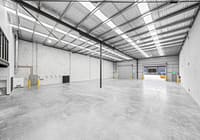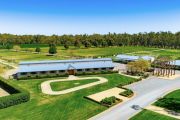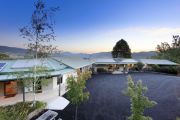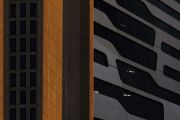
This is how construction sites could become less noisy
Jack-hammering, grinding and drilling are just some of the noises emitted from a construction site that a new product on the market can recognise and measure when paired with artificial intelligence.
Construction workers must not be exposed to noise of 85 decibels or higher over the course of an eight-hour day or 40-hour week, and never exposed to a noise level above 140 decibels, which can damage hearing instantly, according to Safe Work Australia.

The sounds coming from a building site can be frustrating for those around the project as well. Typically, unless granted a specific permit, construction work is permitted during standard business hours, such as from 7am to 6pm during the week.
Addressing and measuring these noises is how SiteHive was born – a company that provides technology to help with environmental management, including noise minimisation as well as water, dust and vibration monitoring in the construction industry.
It’s also why SiteHive’s Audio Classifier has been recognised as the winner in The Australian Financial Review BOSS 2025 Most Innovative Companies in the Property, Construction and Transport category.
The Audio Classifier uses AI to identify and classify construction noise in real time using its integrated hardware and software technology, replacing the traditionally manual process. It aims to save time and provide instant noise classification to address and prevent noise issues on a building site.
By capturing high-fidelity recordings of construction noise in real time, the Audio Classifier then compares the sound against a database of thousands of typical construction and urban noises.
Through building, analysing and labelling different sounds and adding it to its database, SiteHive founders Ben Cooper-Woolley and Adam Ferguson have been able to develop an audio spectrogram transformer model that can recognise and measure specific construction noises such as jack hammering.
And since launching the product just 12 months ago, it’s already been embedded in more than 600 projects across Australia and New Zealand, with more than 11 million audio files classified.
Cooper-Woolley said noise, dust and vibration levels were heavily regulated across the nation by state governments and local councils for construction projects.
“The historical approach that I observed over my 15 years in engineering consultancy with Arup is [traditional methods] just provide a measurement, and it wouldn’t be in real time,” he tells The Australian Financial Review.
“They’d know that a month ago you were over your noise limit or your threshold, or there’d been a noise complaint or the like. But it was very reactive and it was expensive to monitor.”
However, their theory was that they could develop a suite of products that could reduce the cost of monitoring by using emerging digital sensors and secondly, they could surround those sensors with rich, contextual information.
Confident decisions
“So adding to devices, multiple sensors, so one device can measure multiple parameters; noise and dust at once,” Cooper-Woolley says. “We can also add cameras to take images. We can add multiple microphones to tell where noise is coming from. We can add a weather station to see where dust is coming from.
“With this rich context and information, people make much more quick and confident decisions, understanding if [a noise is] not caused by the site or if it is, manage it proactively before exceedances and events occur.”
Cooper-Woolley says while noise regulation and requirements are similar between states, every project has its own environmental impact statement, management plan and compliance measures it had to adhere to.
“What we help do is really demystify and simplify that for the environmental teams, to remove it from a complex web of requirements, to let the technology do the heavy lifting, understanding and implementing their management plan,” he says.
“[We try to give] them the assurance that they are maintaining compliance and measuring and managing everything accordingly.”
Developed in partnership with academia, UTS [University of Technology Sydney] and the construction industry, the Audio Classifier adds to SiteHive’s suite of products which all operate on one subscription model. Every time there is an update across any of its products, every subscriber gets the most up-to-date model in real time.
“When new products are released, everybody gets it,” Cooper-Woolley says.
“That’s one of the big benefits of the model, that you come with us on the journey throughout your project, and the product that you start with will be far less advanced than product that you finish with.
“But we honour the pricing, and we’ll keep all the innovations and new features and functionality deployed regularly to the projects throughout the duration.”
Cooper-Woolley and Ferguson met in 2019 at the Antler Start-Up Incubator. Over the course of eight weeks, a cohort of about 75 individuals had to pair up with a business partner and pitch an idea to the “investment committee” who had the power to provide capital for a percentage of equity in their business.
“Ben and I didn’t know each other before the program and we met through the course of that,” Ferguson says. “We pitched our idea to the investment committee and they gave us some money and we were off and running.”
First prototype
Cooper-Woolley’s background working at global consultancy firm Arup, where he worked on Melbourne Metro Tunnel, was where their inspiration arose to develop an environmental software monitoring platform, he says.
“We felt there was an opportunity with the change in MEMs [micro electromechanical systems] technology, so tiny little chips like we’re using on our phones right now, to change the way that environmental monitoring was undertaken,” Ferguson says.
“[We wanted to] bring some innovation to a space that hadn’t had innovation for quite some time.”
From there, the pair built their first prototype, called the Hexanode – a family name for a number of their products today – with the help of the Antler innovation team who managed to get their product on a construction site within months.
It can measure noise, dust and vibrations within the compact device.
Since their first product, the SiteHive team have been involved in some of Australia’s major projects including the Western Sydney Airport, Sydney Fish Markets, Allianz Stadium, and the Western Harbour Tunnel in NSW, as well as level-crossing removals in Melbourne.
Cooper-Woolley says it is thanks to big construction teams such as Laing O’Rourke, CPB Contractors and John Holland who took a chance on SiteHive early in their business.
“We’ve done all of our development and iteration on site with industry in market, collaborating with project teams across industry. We’ve got a deep research partnership with UTS,” he says.
“Everything has been designed and developed at the coal face with real project teams facing real problems and challenges.
“So we’ve been able to move really quickly, iterating based on live feedback from the site.”
Ferguson says the company has had strong growth over the last six years that they’ve been in business.
“We’re now at 25 staff. We’re on over 350 projects across Australia and New Zealand,” he says. “We have close to 1000 of our monitoring devices in the field, monitoring noise, dust and vibration across construction sites, across courts, in some local councils, some quarries and various operational facilities.”
Communicate effectively
SiteHive’s products aren’t just for those working on a construction site or for those regulating noise, Ferguson says.
“We’re serving multiple stakeholders to make sure that the contractors are doing the right thing, that they’re doing it effectively, and are able to communicate effectively.
“We think there’s definitely a lot more that we can do with the audio classifier, certainly making it more relevant to specific businesses.”
For example, the company is using its products to measure the noise of trams in Melbourne compared to general traffic noise.
While SiteHive’s products were initially used for civil and infrastructure construction, most of its revenue in NSW is now generated from builders.
In terms of what’s next, both founders are focused on what else they can do for the construction industry, and other industries, in Australia and New Zealand.
“We’re certainly looking at vertical markets like ports, working more closely with councils,” Ferguson says.
“We’re doing some work at the moment with Adelaide Council, where not only are they looking to manage some of the local buildings, but also deal with community complaints, things like dogs barking.”
SiteHive will continue to build out its product range as well, and is working on a “weather station”, he says.
In the medium term, it would be a great opportunity to expand globally, but they want to first expand their product range and address the opportunities in their own backyard before looking overseas, Ferguson says.
“But we’ve certainly got a good eye on that for the future.”










